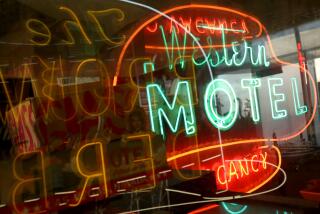Sign Maker Touts Glowing Gel as Shining Alternative to Neon
- Share via
A brightly colored sign intended to lure customers into the Numero Uno pizza shop in Thousand Oaks glows outside the front doors of the establishment. The sign is not neon, as one might suspect, but a newer medium known as Luminite.
The Numero Uno sign is the creation of the folks at Visualite Signs, a Nevada-based sign maker that does all its Luminite manufacturing and R & D out of an Oxnard warehouse.
Visualite Signs, which does business in California as Clear Vision Inc., is one of about two dozen sign manufacturers trying to sell business owners on Luminite, a translucent gel that is hardened under ultraviolet light, applied by machine or hand to a silk-screened Plexiglas panel and backlit with a light box to create the eye-catching final product. The light boxes are separate from the signs, making it easy to change the displays when desired.
Luminite is manufactured by Luminart Inc., a Canadian company that sells the machinery and gels to produce the signs. It is a technology that has tremendous potential for Clear Vision, said CEO Michael Reynolds of Moorpark.
“Our mission is to become the largest production facility in North America using Luminite,” he said. “The obvious businesses to benefit from Luminite are fast-food restaurants, beer and soft drink [companies], retail business for point-of-purchase advertising, all the way up to national franchises.”
Wal-Mart Stores Inc. is among the companies with national scope that have used Luminite signs.
Clear Vision, founded in December 1994, is owned by a group of international investors and operated by Reynolds & Assoc., a corporate turnaround specialist that took control of the business in March 1995. Clear Vision has sales offices in Salt Lake City, Toronto and Montreal and manufactures other products at its Canadian locations.
Reynolds said the company dedicated its first 18 months to research and development, creating prototypes to help sell the Luminite process. Over the last three months, he said, Clear Vision has incorporated digitally printed backgrounds that add high-quality graphics to their signs.
“Over the last few weeks, we’ve really obtained the level we were looking for,” he said. “I understand it’s new, and people resist change, but it just takes diligence.”
Rich Maier, owner of Numero Uno, already is sold on the idea.
“My outside sign has worked really well for me,” he said. “I think the crispness of the graphics is really what does it. It just catches the attention and it’s not gaudy.”
In addition to his outdoor sign, Maier has one on the inside hawking appetizers. A third sign, this one to hang over the salad bar, should be in place by the end of this week. Maier, who also owns Numero Unos in Simi Valley and North Hollywood, said he plans to order signs for the Simi Valley location as well.
A 2-by-2-foot sign, with the light box, sells for $175 to $225 from Clear Vision.
Since Luminite products were introduced in 1993, there have been numerous comparisons to neon signs. Neon is a colorless gas that glows when put inside a tube and electrified.
But Chuck Courson, vice president of corporate communications for Luminart, said he doesn’t like the comparisons. He said the two sign mediums serve different purposes.
“Neon is a good product. There are times when an application calls for neon and there are times when it calls for Luminite,” he said. “Where is the sign going to be placed? If it’s in the front window of a store, maybe neon is best. If it’s inside the store and you want to be able to change the message, there’s no better medium than Luminite.”
That’s what Barry Brenner, co-owner of the Cycle Scene bicycle store in Ventura, is counting on. Last week he installed, inside his store, a Luminite sign that incorporates a photo of a rider on a mountain bike.
“The intent is to make the shopping experience for the customer more exciting in the store,” Brenner said, “to surround them with action photographs of the sport we are selling and make them more excited about participating in it.”
Luminart reported sales of their machinery and gel totaling $7.2 million in Canadian dollars for the fiscal year ending March 31, 1995, and $9.8 million Canadian for the nine-month period ending Dec. 31, 1995. Courson estimated fiscal 1995 year-end sales, to be released in July, to reach $14 million Canadian.
More to Read
Inside the business of entertainment
The Wide Shot brings you news, analysis and insights on everything from streaming wars to production — and what it all means for the future.
You may occasionally receive promotional content from the Los Angeles Times.









